Falling in love with someone from another country can be exhilarating, but marrying a US citizen involves more than just planning a wedding. Whether your goal is to start a life together in the United States or simply understand the legal requirements, knowing the steps and potential challenges is essential. This guide breaks down the process, offering practical advice for a smoother journey from engagement to marriage and beyond.
Understanding the Legal Basics
Marrying a US citizen carries significant implications not just for your personal relationship but also for immigration. For most non-US citizens, the primary route to living in the United States is obtaining a green card through marriage, which provides lawful permanent residency. It’s crucial to understand that marrying a US citizen does not automatically grant citizenship—there are specific forms, procedures, and timelines that must be carefully followed.
Your US citizen spouse must be legally recognized as such, and your marriage must be legally valid in the country or state where it took place. For foreign spouses living outside the United States, consular processing is typically required: the US citizen spouse files a petition, and the foreign spouse completes visa processing at a US consulate abroad before entering the country. It’s important to note that entering into a sham marriage solely to obtain immigration benefits is illegal and can result in severe consequences, including fines, deportation, and criminal charges.
Preparing for the Marriage Process
Before you tie the knot, you and your partner should discuss your long-term plans. If you intend to live in the United States, the US citizen spouse typically files a petition (Form I-130) on behalf of their foreign spouse. This petition establishes the legitimacy of your relationship and starts the immigration process. It’s crucial to gather documents such as birth certificates, passports, proof of the relationship, and prior marriage records if applicable.
If your marriage occurs abroad, the process can be slightly more complex. You may need to obtain a fiancé(e) visa (K-1 visa) first, allowing you to enter the United States and marry within 90 days. After marriage, the foreign spouse can then apply for adjustment of status to obtain a green card. This process involves additional forms, fees, and interviews, so patience and thorough preparation are key.
Navigating the Interview and Documentation
A major part of the immigration process is demonstrating that your marriage is genuine. The US Citizenship and Immigration Services (USCIS) may require an in-person interview where both spouses are asked questions about their relationship, daily routines, and future plans. Honest answers and consistent documentation are vital. Supporting evidence might include joint bank accounts, shared leases or property ownership, photographs, travel records, and communication logs.
It’s also wise to maintain copies of all correspondence and receipts for fees paid, as missing documentation can delay the process. Consulting with an immigration attorney can be highly beneficial, particularly if your situation involves previous marriages, children, or complicated travel histories.
Planning the Wedding and Life Together
While immigration procedures are critical, don’t forget the personal side of your journey. Planning a wedding involves emotional and logistical preparation, from choosing a venue to blending families. Many couples find that combining these plans with immigration steps requires careful scheduling, especially if visas or travel restrictions are involved.
Communication is the cornerstone of a successful marriage across borders. Discuss finances, career goals, living arrangements, and cultural expectations openly. These conversations can prevent misunderstandings and strengthen your relationship during a time that can be stressful and bureaucratic.
After the Marriage
Once married and with a green card in hand, the foreign spouse gains lawful permanent residency. Typically, if the marriage is less than two years old at the time of approval, the green card is conditional and valid for two years. To remove conditions, couples must file Form I-751 jointly within 90 days of the card’s expiration. Successful removal grants a permanent 10-year green card.
Over time, a permanent resident may become eligible for US citizenship through naturalization, generally after three years of marriage to a US citizen, provided other requirements are met, such as continuous residency, good moral character, and English language proficiency.
Final Thoughts
Marrying a US citizen is both a personal and legal journey. While love is the foundation, understanding immigration procedures, timelines, and responsibilities ensures a smoother transition and reduces stress. With careful planning, open communication, and adherence to legal requirements, couples can successfully navigate this journey and build a life together in the United States.
Marriages are about commitment, trust, and partnership—marrying across borders adds a layer of legal complexity, but it also brings the reward of shared dreams and new opportunities. By staying informed and prepared, you can focus on what truly matters: celebrating your love and starting your life together.







